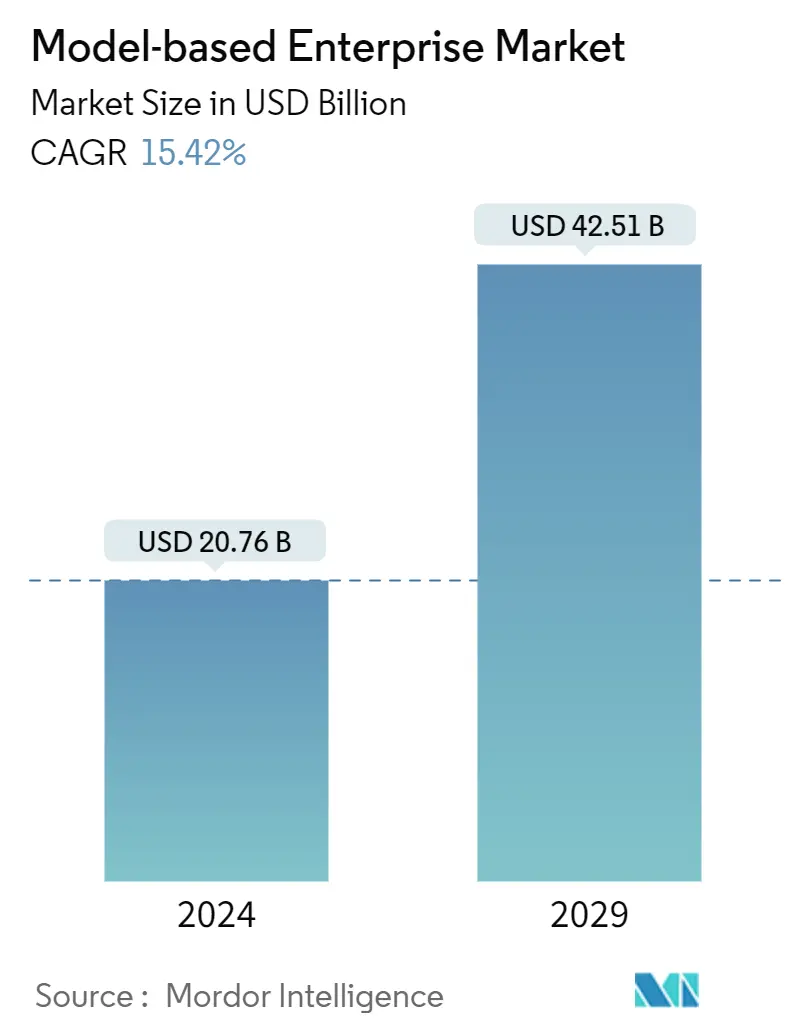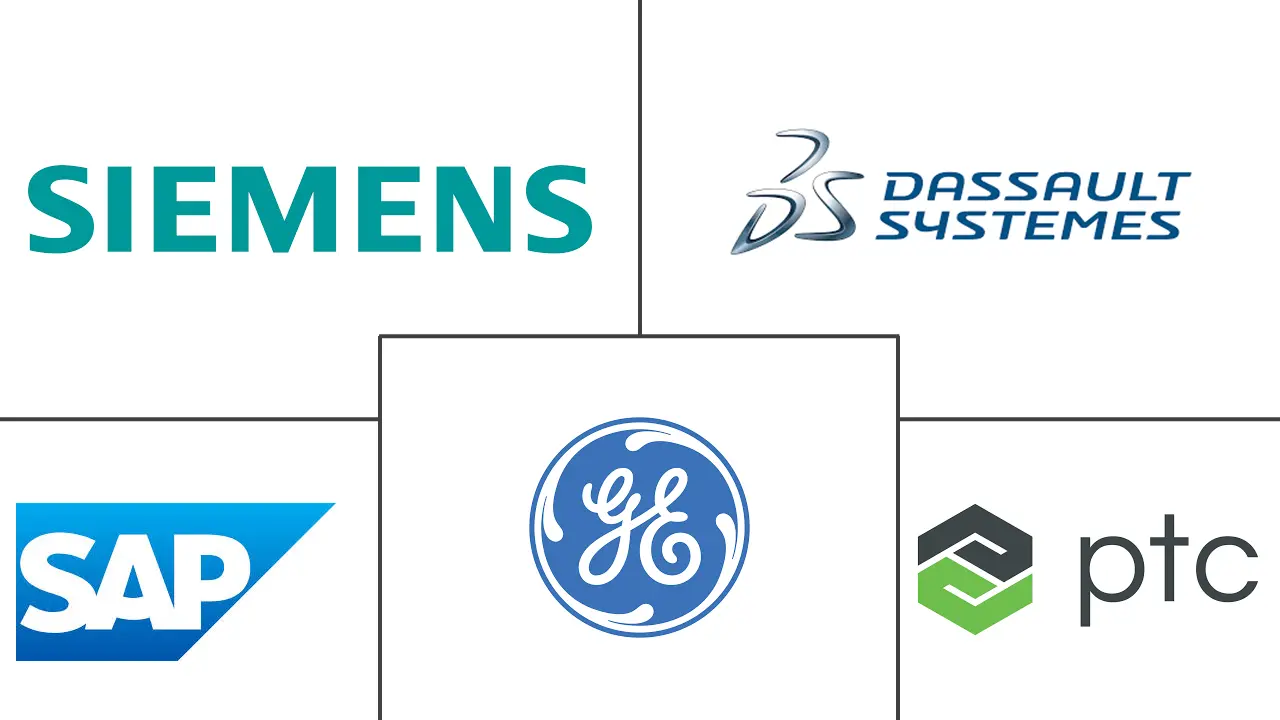Market Size of Model-based Enterprise Industry

| Study Period | 2019 - 2029 |
| Market Size (2024) | USD 20.76 Billion |
| Market Size (2029) | USD 42.51 Billion |
| CAGR (2024 - 2029) | 15.42 % |
| Fastest Growing Market | Asia Pacific |
| Largest Market | North America |
Major Players
*Disclaimer: Major Players sorted in no particular order |
Model-Based Enterprise Market Analysis
The Model-based Enterprise Market size is estimated at USD 20.76 billion in 2024, and is expected to reach USD 42.51 billion by 2029, growing at a CAGR of 15.42% during the forecast period (2024-2029).
The increasing adoption of 3D technology across multiple industry verticals to cater to the increasing demand for emerging applications, varying from shape analysis to 3D modeling, has given rise to developing and adopting model-based enterprise solutions that gauge product shapes in real-time. The technology offers many opportunities to design, produce, and perform novel architectural forms, construction systems, etc. It is an innovative, faster, and more agile product development and production method.
• Diverse manufacturing industries are adopting digital technologies due to the rapidly growing capabilities of the software used, boosting market growth. With the introduction of CAD, 3D models have become the new industry standard for designing products, tooling, and manufacturing processes.
• Industry 4.0 adopted digital technologies to enhance, automate, and modernize processes. Integrating different technologies, such as 3D technologies, is prevalent, as these technologies provide exceptional benefits, especially in the discrete manufacturing sector. The consumer product manufacturing industry is transforming from mass production to an industry indicated by mass customization. The process of how products are designed and delivered needs a new level of sophistication and metric that analyzes a complex set of data for deep insights.
• Industries are witnessing increased adoption of reverse engineering for its fast-rapid prototyping abilities and accuracy associated with producing new parts. Reverse engineering requires a strong, robust image acquisition system to acquire data accurately.
• Deployment of 3D technology and solutions could enable manufacturers to achieve such objectives, boosting market growth. Most OEMs and many larger suppliers are now model-centric, where 3D models are created and used downstream. As the automotive industry transitions to the 3D environment, virtual product models offer them the opportunity to promote reuse, improve design efficiency, improve quality, and reduce cost across the enterprise.
• Some challenges the market faces are a shortage of skilled workers, data security concerns, and the initial investment costs hindering business operations. Addressing these challenges is essential for companies to fully realize the benefits of model-based enterprise and stay competitive in today's digital manufacturing landscape.
• The state of the world economy significantly shapes the demand for model-based enterprise (MBE) solutions across industries. Businesses' decisions to invest in digital transformation projects, including adopting MBE practices, are influenced by economic factors such as GDP growth, industrial production, and capital expenditure. Businesses are more inclined to devote money to innovation and efficiency improvement projects during economic expansion, which raises the need for MBE solutions.
• For instance, according to a World Bank estimate, the North American GDP, which was USD 32.32 trillion in 2023, is predicted to increase by 1.5% in 2023-24, suggesting that corporate activity and possible model-based enterprise solutions investments are projected to flourish.
Model-Based Enterprise Industry Segmentation
Model-based enterprise (MBE) is an engineering strategy that primarily aims to clarify the design intent during the manufacturing process by using a 3D model-based definition that includes all the product and manufacturing process information associated with the product's manufacturing.
The model-based enterprise market is segmented by offering (solutions and services), deployment mode (on-premise and cloud), end user (aerospace and defense, automotive, construction, power and energy, retail, and other end users), and geography (North America, Europe, Asia-Pacific, Latin America, and Middle East and Africa). The market size and forecasts are provided in terms of value in USD for all the above segments.
| By Offering | |
| Solutions | |
| Services |
| By Deployment Mode | |
| On-premise | |
| Cloud |
| By End User | |
| Aerospace and Defense | |
| Automotive | |
| Construction | |
| Power and Energy | |
| Retail | |
| Other End Users |
| By Geography | |
| North America | |
| Europe | |
| Asia-Pacific | |
| Latin America | |
| Middle East and Africa |
Model-based Enterprise Market Size Summary
The model-based enterprise market is experiencing significant growth, driven by the increasing adoption of 3D technology across various industry sectors. This technology is becoming the standard for designing products, tooling, and manufacturing processes, particularly in the automotive and consumer product industries. The shift towards digital transformation, including the integration of Industry 4.0 principles, is enhancing, automating, and modernizing manufacturing processes. This transition is facilitating mass customization and improving product design and delivery through sophisticated data analysis. Despite challenges such as a shortage of skilled workers and data security concerns, the market is poised for expansion as businesses recognize the benefits of model-based enterprise solutions in enhancing efficiency and reducing costs.
North America is expected to hold a significant share of the global model-based enterprise market, supported by major players like GE, PTC, Autodesk, and Aras. The region's automotive industry is increasingly adopting these solutions, with the United States being a major market. Initiatives like the National Institute of Standards and Technology's MBE Summit are promoting the adoption of digital models across product lifecycles. The solution segment is anticipated to grow robustly, driven by smart city projects and Industry 4.0 initiatives. Companies are forming long-term collaborations to enhance security and streamline processes, with key players such as Siemens AG, Dassault Systèmes SE, and SAP SE leading the market. Recent developments, like Autodesk's launch of Autodesk Informed Design and Aras's partnership with Johnson Matthey, highlight the ongoing innovation and strategic advancements in the sector.
Model-based Enterprise Market Size - Table of Contents
-
1. MARKET INSIGHTS
-
1.1 Market Overview
-
1.2 Industry Attractiveness - Porter's Five Forces Analysis
-
1.2.1 Threat of New Entrants
-
1.2.2 Bargaining Power of Buyers/Consumers
-
1.2.3 Bargaining Power of Suppliers
-
1.2.4 Threat of Substitute Products
-
1.2.5 Intensity of Competitive Rivalry
-
-
1.3 Assessment of Macroeconomic Factors on the Market
-
-
2. MARKET SEGMENTATION
-
2.1 By Offering
-
2.1.1 Solutions
-
2.1.2 Services
-
-
2.2 By Deployment Mode
-
2.2.1 On-premise
-
2.2.2 Cloud
-
-
2.3 By End User
-
2.3.1 Aerospace and Defense
-
2.3.2 Automotive
-
2.3.3 Construction
-
2.3.4 Power and Energy
-
2.3.5 Retail
-
2.3.6 Other End Users
-
-
2.4 By Geography
-
2.4.1 North America
-
2.4.2 Europe
-
2.4.3 Asia-Pacific
-
2.4.4 Latin America
-
2.4.5 Middle East and Africa
-
-
Model-based Enterprise Market Size FAQs
How big is the Model-based Enterprise Market?
The Model-based Enterprise Market size is expected to reach USD 20.76 billion in 2024 and grow at a CAGR of 15.42% to reach USD 42.51 billion by 2029.
What is the current Model-based Enterprise Market size?
In 2024, the Model-based Enterprise Market size is expected to reach USD 20.76 billion.

